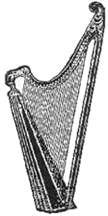|
             
Copyright
Helen Forder
2004
|
|
The
Harp, by Brinley Richards ...
continued
|
page 4
|
|
If we admit that the harp
was as popular in Ireland as in Wales, what are we to believe of Scotland, "which excelled even Ireland"? Giraldus, after describing the wonderful skill of
the Irish harpers, says, "In the
opinion of many, however, Scotland has not only attained to the excellence
of Ireland, but has, even in musical science and ability, far surpassed it;
insomuch that it is to that country they now resort as to the genuine
source of art". This evidence is of
no value whatever. Giraldus never visited Scotland, and merely wrote from
hearsay. Whether the Scotch were really familiar with the use of the harp
or not, the old historian, John Major, states that it was a royal
accomplishment (Annals of Scotland, 1521).
|

|
|
In enumerating the talents
of King James, he says; "Musicus
artificiosus, nulli secundus, in Cytharâ. Tanquem alter Orpheus, Hiberenses
aut Silvestres Scotos, qui in illa arte praecipui erant, exsuperabat".
(He was a skilled musician; second
to none on the Cythara. As though he had been another Orpheus, he excelled
the Irish or Highland Scots, who are esteemed the best performers on that
instrument.) In a work called Certaine
Matters concerning the Realme of Scotland, 1597, we learn something of
the manner of stringing and playing: "They
(the Scotch) delight much in musicke, but chiefly in harpes and clairschoes
of their own fashion." The harps
were strung with sinews, as in Wales, and the clairschoes with
brass wire, "which strings they stryke
with their nayles growing long".
This at once proves the use of two distinct kinds of harp; but what these
really were, it is difficult to imagine. Probably there was as great a
difference between ancient and modern harps as between the old Citole and a
modern 'Broadwood'.
|
|
In former days it was the
custom in Scotland, as in Wales, to have harpers at the head-quarters of
the army; and the Earl of Argyle had his own harper with him at the battle
of Strathaven, October 3rd, 1594. On that occasion, we learn the army
"was accompanied by a sorceress or
witch, who prophesied that on the following Friday, the day after the
battle, Argyle's harp should be played in Buchan, and the bagpipe should
sound in Strathbogie". The
chronicler adds, "both prophesies were
fulfilled".
|
|
back 1 2 3 4 5 6 7 8 next
|
|

